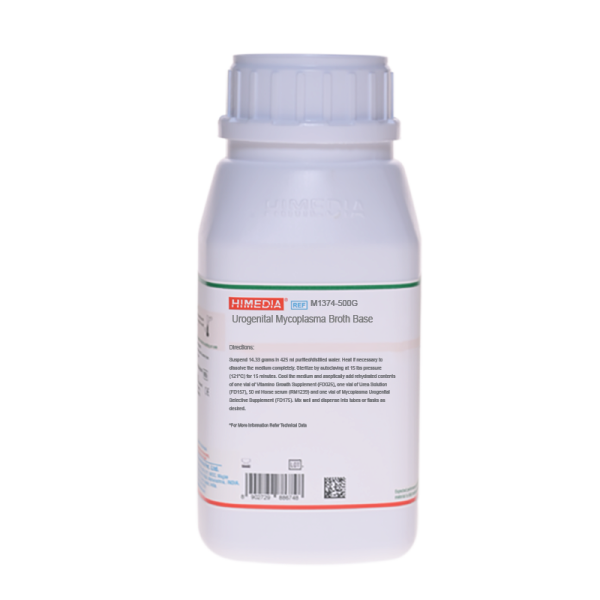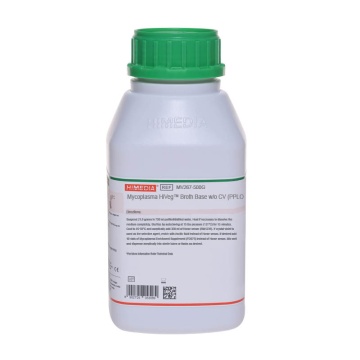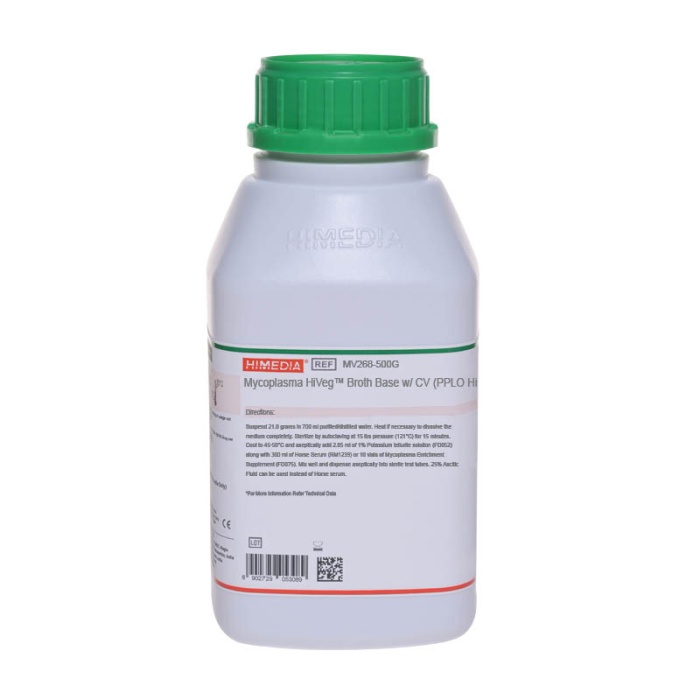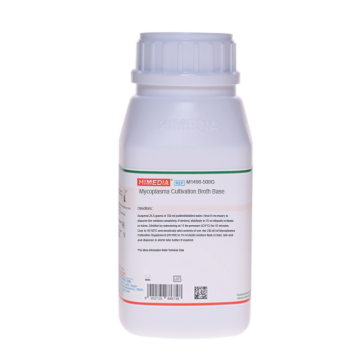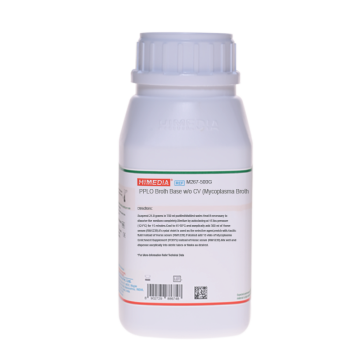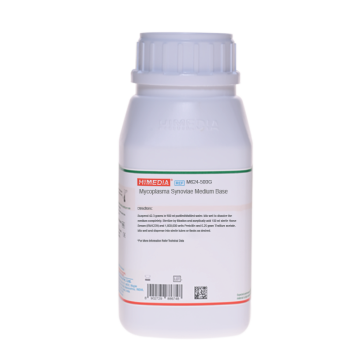 Your enquiry has been submitted
Your enquiry has been submitted
Mycoplasma Urogenital Broth Base (Urogenital Mycoplasma Broth Base)
Mycoplasma#CC293D
Intended Use
Recommended for selective cultivation of Mycoplasma hominis and Ureaplasma urealyticum.
Composition**
| Ingredients | g/L |
|---|---|
| HI powder # | 8.000 |
| Tryptone | 8.000 |
| Yeast extract | 4.000 |
| Sodium chloride | 3.500 |
| Arginine hydrochloride | 5.000 |
| L-Cysteine hydrochloride | 0.100 |
| Phenol red | 0.050 |
| Final pH (at 25°C) | 6.3±0.2 |
**Formula adjusted, standardized to suit performance parameters # Equivalent to Heart infusion powder
Directions
Suspend 14.33 grams in 425 ml purified/distilled water. Heat if necessary to dissolve the medium completely. Sterilize by autoclaving at 15 lbs pressure (121°C) for 15 minutes. Cool the medium and aseptically add rehydrated contents of 1 vial of Vitamino Growth Supplement (FD025), 1 vial of U5 Supplement (FD157), 50 ml Horse serum (RM1239) and 1 vial of PAN Selective Supplement (FD175). Mix well and dispense into tubes or flasks as desired.
Principle And Interpretation
The two Mycoplasma species Mycoplasma hominis and Ureaplasma urealyticum, have been implicated in urogenital infections in men and women. The organisms are also much smaller than most bacteria measuring 0.2 to 0.3 µm, hence they are able to pass through bacteriological filters. These organisms differ from other bacteria in that they lack a rigid cell wall. Individual cells are bound only by trilaminae unit membrane. Thus cultivation of Mycoplasma and Ureaplasma requires an enriched medium containing precursors for nucleic acid, protein and lipid biosynthesis. Precursors for nucleic acids and proteins are provided principally by the enriched basal peptone medium and yeast extract, while lipids are provided by the inclusion of serum. In fact, one of the principle criteria used in the taxonomic classification of these organisms is the requirement for the complex lipid cholesterol in the growth medium by certain Mycoplasma and Mycoplasma-like organisms (1). Urogenital Mycoplasma Broth Base (Mycoplasma Urogenital Broth Base) is based on the formula used by Bebear et al (2,3), Fiacco et al (4), Bonissol and Daoulas (5), Renaudin et al (6) and Bauriaud et al (7). This medium is used for selective cultivation of urogenital Mycoplasma, viz. M. hominis and U. urealyticum from clinical samples.
The medium contains tryptone and HI powder, which provide necessary nutrients for the growth of Mycoplasma and Ureaplasma. Yeast extract provides preformed nucleic acid precursors, necessary for the growth of fastidious Mycoplasma. Many Mycoplasmas require serum for their good growth and also presence of antibiotics (present in PAN Selective Supplement, FD175) is necessary to prevent the growth of accompanying microbial flora. Sodium chloride maintains the osmotic balance. Phenol red acts as a pH indicator. M. hominis metabolizes arginine to ammonia via ornithine by a three enzyme system, resulting in increase in the pH of the medium which is indicated by a colour change to red. Ureaplasma possess the enzyme urease and breakdown urea to ammonia indicated by a colour change to red-orange. Additional tests are required for the differentiation between M. hominis and U. urealyticum.
U. urealyticum usually causes a colour change in the broth within 24 hours except when the titre is low, the change is observed within 48 hours. M. hominis usually causes the colour change within 48 hours. When the titre is high, the colour change occurs within 24 hours. A negative broth should remain clear or may show a faint haze. High turbidity in the broth indicates presence of contaminants.
Type of specimen
Clinical samples - nasopharyngeal and oropharyngeal swabs
Specimen Collection and Handling
For clinical samples follow appropriate techniques for handling specimens as per established guidelines (8,9). After use, contaminated materials must be sterilized by autoclaving before discarding.
Warning and Precautions :
In Vitro diagnostic Use only. For professional use only. Read the label before opening the container. Wear protective gloves/protective clothing/eye protection/face protection. Follow good microbiological lab practices while handling specimens and culture. Standard precautions as per established guidelines should be followed while handling clinical specimens. Safety guidelines may be referred in individual safety data sheets.
Limitations :
- Since Mycoplasma species are aerobic or facultatively anaerobic but some are microaerophilic, proper incubation should be carried out for optimal recovery.
- High turbidity in the broth indicates presence of contaminants.
Quality Control
Appearance Light yellow to pink homogeneous free flowing powder
Colour and Clarity of prepared medium Reddish pink coloured clear solution in tubes
Reaction Reaction of 2.86% w/v aqueous solution at 25°C. pH: 6.3±0.2
pH 6.10-6.50
Cultural Response Cultural response observed after an incubation at 35-37°C for 48 hours to one week with added Vitamino Growth Supplement (FD025), U5 Supplement (FD157), Horse Serum (RM1239) and PAN Supplements (FD175).
| Organism | Growth | Arginine | Urea |
|---|---|---|---|
| Mycoplasma hominis ATCC 14027 | good-luxuriant | positive reaction, red colour | negative reaction, no colour change |
| Ureaplasma urealyticum ATCC 27618 | good-luxuriant | negative reaction, no red colour | positive reaction, red-orange colour |
Storage and Shelf Life
Store below 10-30°C in a tightly closed container and the prepared medium at 2-8°C. Use before expiry date on the label. On opening, product should be properly stored dry, after tightly capping the bottle inorder to prevent lump formation due to the hygroscopic nature of the product. Improper storage of the product may lead to lump formation. Store in dry ventilated area protected from extremes of temperature and sources of ignition. Seal the container tightly after use. Product performance is best if used within stated expiry period.
Disposal
User must ensure safe disposal by autoclaving and/or incineration of used or unusable preparations of this product. Follow established laboratory procedures in disposing of infectious materials and material that comes into contact with clinical sample must be decontaminated and disposed of in accordance with current laboratory techniques (8,9).
Reference
- Tully J. G., Taylor-Robinson D., 1986, Pediatr. Infect. Dis. 5: 5292-5295
- Bebear C., De Barbeyrac B., Bernet C., Renaudin H., 1989, Ann. Biol. Clin., 47, 415-420.
- Bebear C., Renaudin H., Maugeim J., De Barbeyrac B., Clerc M. T., 1990, Zsntralblatt 20, 77-82.
- Fiacco V., Miller M. J., Carney E., Martin W. J., 1984, J. Clin. Microbiol., 20, 882-865.
- Bonissol C., Daoulas-Lebourdelles F., 1979, Sem. Hop. Paris, 13-14, 670-677.
- Renaudin H., Quentin C., De Barbeyrac B., Bebear C., 1988, Pathologie Biologie, 36-496-499.
- Bauriaud R., Seror C., Lareng M. B., Lefevre J. C., 1992, Pathologie Biologie, 40, 479-482.
- Isenberg, H.D. Clinical Microbiology Procedures Handbook 2nd Edition.
- Jorgensen, J.H., Pfaller, M.A., Carroll, K.C., Funke, G., Landry, M.L., Richter, S.S and Warnock., D.W. (2015) Manual of Clinical Microbiology, 11th Edition. Vol. 1.
| Product Name | Mycoplasma Urogenital Broth Base (Urogenital Mycoplasma Broth Base) |
|---|---|
| SKU | M1374 |
| Product Type | Regular |
| Physical Form | Powder |
| Origin | Animal |
| Packaging type | HDPE |
| References | 1. Bebear C., De Barbeyrac B., Bernet C., Renaudin H., 1989, Ann. Biol. Clin., 47, 415-420. |
| Customized Product Available | No |



